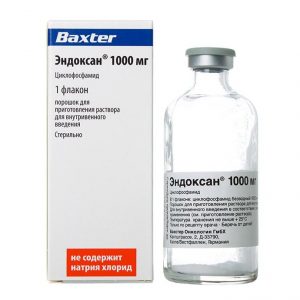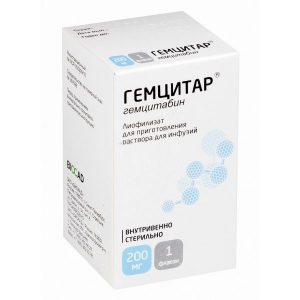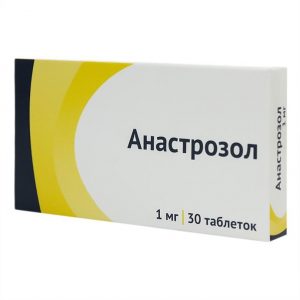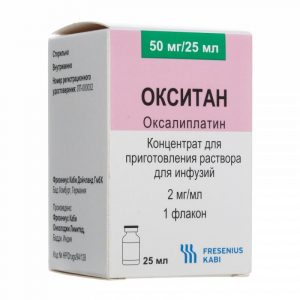Description
Latin name
CAELYX ®
Release form
Concentrate for the preparation of a solution for iv administration.
Packing
In a bottle of 10 ml. In a cardboard box 1 bottle.
Pharmacological action
Pharmacodynamics
Antitumor drug. Doxorubicin is a cytotoxic anthracycline antibiotic isolated from Streptomyces peucetius var. caesius. The exact mechanism of the antitumor effect of doxorubicin is unknown. Believe that the cytotoxic effect is due to its ability to inhibit the synthesis of DNA, RNA and proteins by introducing doxorubicin between adjacent pairs of DNA double helix bases, which prevents the unfolding of the helix for subsequent replication.
Kelix ® is a pegylated liposomal form of doxorubicin that circulates for a long time in the blood and provides a higher concentration of doxorubicin in tumor tissue than in normal tissues. Liposomes contain surface-bound hydrophilic polymers of methoxypolyethylene glycol (MPEG). The linear groups of MPEG create a protective membrane protruding above the surface of the liposomes, which reduces the possibility of interaction between the lipid bilayer membrane and plasma components, which protects liposomes from recognition by the phagocytic system and allows you to extend the circulation time of doxorubicin in the bloodstream. Pegylated liposomes also have a low permeability lipid matrix and an internal aqueous buffer system, which in combination allows to keep doxorubicin inside the liposome during its circulation in the bloodstream. The sufficiently small size of the pegylated liposomes (average diameter of approximately 100 nm) allows them to penetrate through the defects of the blood vessels of the tumor. The results of experimental studies indicate the penetration of pegylated liposomes from blood vessels and their cumulation in the tumor.
Pharmacokinetics
Distribution and excretion of
With iv administration of Kelix ®, the concentration of doxorubicin in plasma and AUC mainly refers to pegylated liposomal doxorubicin (from 90% to 95% of the measured doxorubicin, respectively), and significantly higher than when administered with equivalent doses non-pegylated non-liposomal) doxorubicin. The pharmacokinetic profile of doxorubicin indicates that its clearance from blood plasma is determined by a liposome carrier. Doxorubicin becomes available only after liposomes exit the vascular bed and penetrate into the tissues.
At low doses (10-20 mg / m2), linear pharmacokinetics of Kelix is shown, at higher doses (20-60 mg / m2) nonlinear.
With the introduction of the drug in a dose of 10 to 60 mg / m2, the clearance of doxorubicin averages 0, 03 l / h / m2 (0.008-0.152 l / h / m2), Vd – 1.93 l / m2 (0.96-3.85 l / m2), T1 / 2 – 73.9 h (24-231 h).
Pharmacokinetics in special clinical cases
Pharmacokinetic parameters for impaired liver function and hyperbilirubinemia do not differ significantly from the pharmacokinetic parameters of normal total bilirubin concentration.
Renal failure (CC 30-156 ml / min) does not affect the pharmacokinetic parameters. There is no data on the pharmacokinetics of the drug in patients with creatinine clearance less than 30 ml / min.
The age of patients (21-75 years) does not significantly affect the pharmacokinetic parameters of Kelix ®.
Indications
Metastatic breast cancer in the presence of indications for therapy with anthracyclines, incl. in the case of an increased risk of cardiological complications and the ineffective treatment of
taxanes, widespread ovarian cancer with the ineffective chemotherapy of platinum preparations
progressive multiple myeloma (in combination with bortezomib) in patients who received at least one chemotherapy line and underwent bone marrow transplantation (BMT) , or who are not candidates for BMT.
Contraindications
Age under 18
pregnancy
lactation (breastfeeding)
hypersensitivity to the components of the drug.
Caution: the drug should be used in case of circulatory failure, previous use of other anthracyclines, co-administration with drugs with a cytotoxic (especially myelotoxic) effect, gout (including a history), urate nephrourolithiasis (including a history), heart diseases (cardiotoxic effect may occur with more low total doses), liver failure.
Inhibition of bone marrow hematopoiesis (including bone marrow infiltration with tumor cells, prior chemotherapy or radiation therapy), parasitic and infectious diseases of a viral, fungal or bacterial nature (currently or recently transferred, including recent contact with the patient: herpes simplex herpes zoster / viremic phase /, chickenpox, measles, amoebiasis, strongyloidosis (established or suspected) increase the risk of developing a severe generalized disease.
Use during pregnancy and lactation
The drug is contraindicated for use during pregnancy and during breastfeeding.
Men and women of childbearing age during treatment, and also within 6 months after its cancellation should use reliable methods of contraception.
Composition
1 ml (1 vial) contains:
Active ingredients: doxorubicin hydrochloride pegylated liposomal 2 mg (20 mg).
Excipients: sodium carbamoylmethoxypolyethylene glycol distearoylglycerophosphoethanolamine, phosphatidylcholine, cholesterol (cholesterol), ammonium sulfate, sucrose, histidine, hydrochloric acid, sodium hydroxide, water d / and.
Dosage and administration
The drug is administered intravenously. The drug should not be administered jet or undiluted.
Treatment is continued until signs of progression or development of unacceptable toxicity appear.
For breast and ovarian cancer, the drug is administered at a dose of 50 mg / m2 once every 4 weeks.
In the treatment of multiple myeloma, Kelix ® is administered at a dose of 30 mg / m2 on the 4th day of a three-week cycle in combination with bortezomib (1.3 mg / m2 on days 1, 4, 8 and 11). Kelix is administered immediately after bortezomib. If it is impossible to administer Kelix ® and bortezomib on the 4th day of the cycle, their administration can be postponed for 48 hours. If the administration of bortezomib was made later than the time indicated by the treatment regimen, then the subsequent administration of bortezomib should be carried out no earlier than 72 hours after the last dose.
With a calculated dose of less than 90 mg, the concentrate is diluted in 250 ml of a 5% dextrose solution for infusion at a dose of 90 mg or more in 500 ml.
The first administration is carried out at a rate of not more than 1 mg / min in order to reduce the risk of developing infusion reactions. In the absence of reactions, subsequent infusions can be carried out for 60 minutes.
Administration of the drug to patients who have had an infusion reaction to the previous administration should be modified as follows: 5% of the calculated dose is administered slowly over 15 minutes. In the absence of reactions, administration is continued at a double rate for another 15 minutes. With good tolerance, the infusion is continued for the next hour (total administration time is 90 minutes).
Intravenous catheter and dropper between the introduction of bortezomib and Kelix should be washed with 5% dextrose solution.
Modification of the dosing regimen
Instructions for changing the dosing regimen of the Kelix ® preparation are given in Tables 1-4.
The toxicity levels given in the tables are based on the National Cancer Institute’s Toxicity Scale (NCI-CTC).
Table 1. Modification of the dosing regimen due to the development of palmar-plantar syndrome
Toxicity after previous administration of the sellkp preparation Kelix ®
Dose adjustment of the Kelix ®
drug I degree (moderate erythema, edema, or desquamation, not affecting daily activities)
Introduce the drug in the initial dose, with the exception of those patients who previously had a 3-4 degree of toxicity. In the latter case, postpone treatment for 2 weeks. Resume therapy in a dose reduced by 25%, observing the initial interval between administrations.
II degree (erythema, desquamation, edema, affecting daily physical activity, but not limiting its small blisters or ulcers (
Postpone treatment for 2 weeks or until toxicity decreases to a degree of 0-1. In those patients who have not previously 3-4 degree of toxicity was noted, treatment can be continued in the initial dose and in the previous mode.If patients with 3-4 degree toxicity were previously noted, therapy should be resumed in a dose reduced by 25%, observing the initial interval between administrations.
If, after 2 weeks, no reduction in toxicity is noted, treatment with Kelix should be discontinued.
III degree (blisters, ulcerations, swelling that interferes with walking or daily activities, the patient cannot wear normal clothes and shoes)
Postpone treatment for 2 weeks or until toxicity decreases to 0-1. Therapy should be resumed in a dose reduced by 25%, observing the initial interval between administrations.
If, after 2 weeks, no reduction in toxicity is noted, treatment with Kelix should be discontinued.
IV degree (diffuse or local processes leading to infectious complications, bed rest or hospitalization)
Postpone treatment for 2 weeks or until toxicity decreases to degree 0-1.
Therapy should be resumed in a dose reduced by 25%, observing the initial interval between administrations.
If, after 2 weeks, no reduction in toxicity is noted, treatment with Kelix should be discontinued.
Table 2. Dosing regimen modification due to the development of stomatitis
Toxicity after previous administration of
preparation Kelix ®
Dose adjustment for Kelix ®
I degree (painless ulcers, erythema or mild pain)
Enter the drug in the initial dose, except those patients who previously had a 3-4 degree of toxicity. In the latter case, postpone treatment for 2 weeks. Resume therapy in a dose reduced by 25%, observing the initial interval between administrations.
II degree (painful erythema, edema or ulcers, but the patient can eat)
Postpone treatment for 2 weeks or until toxicity decreases to a degree of 0-1. In those patients who have not previously been observed 3-4 degree of toxicity, treatment can be continued in the initial dose and in the previous regimen. If patients have previously been observed toxicity of 3-4 degrees, therapy must be resumed in a dose reduced by 25%, observing the initial interval between administrations. If after 2 weeks there is no decrease in toxicity, treatment with Kelix should be discontinued.
III degree (painful erythema, swelling or ulcers, the patient cannot eat)
Postpone treatment for 2 weeks or until toxicity decreases to a degree of 0-1.
Therapy should be resumed in a dose reduced by 25%, observing the initial interval between administrations.
If, after 2 weeks, no reduction in toxicity is noted, treatment with Kelix should be discontinued.
IV degree (the state requires parenteral or enteral nutrition)
Postpone treatment for 2 weeks or until toxicity decreases to degree 0-1.
Therapy should be resumed in a dose reduced by 25%, observing the initial interval between administrations.
If, after 2 weeks, no reduction in toxicity is noted, treatment with Kelix should be discontinued.
Table 3. Dosage regimen modifications due to the development of hematological toxicity
Neutrophils (in 1 μl)
Platelets (in 1 μl)
Change in dosing schedule
1 degree
1500-1900
75 000-150 000
Continuation of therapy .
2 degree
1000 –
50,000-
When restoring the number of neutrophils to 1,500 or more and platelets to 75,000 or more, continue treatment without reducing the dose.
3 degree
500-
25,000-
When restoring the number of neutrophils to 1,500 or more and platelets to 75,000 or more, continue treatment without reducing the dose.
4 degree
Less than 500
Less than 25,000
When restoring the number of neutrophils to 1,500 or more and platelets to 75,000 or more, continue treatment by reducing the dose by 25%, or continue treatment at the same dose with the addition of cytokines.
Table 4. Dosage regimen modification for multiple myeloma
Patient status
Kelix ®
Fever> 38 ° C and neutrophil count <1000 / μl Do not administer the drug in this cycle, if an undesirable reaction occurs before the 4th day. If it is observed after the 4th day, then reduce the next dose by 25%. On any day of drug administration after the 1st day of each cycle: Platelet count <25,000 μl Hemoglobin <8 g / dl Number of neutrophils <500 μl Do not administer the drug in this cycle if an undesirable reaction occurs before the 4th day. If it is observed after the 4th day, then reduce the next dose by 25% if the dose of bortezomib is reduced due to hematological toxicity. * Non-hematologic drug toxicity grade 3-4 Do not administer the drug until toxicity decreases to Neuropathic pain or peripheral neuropathy Dose adjustment is not required * – more detailed information is presented in the instructions for use of bortezomib. If a patient with multiple myeloma receiving combination therapy with Kelix ® and bortezomib develops palmar-plantar syndrome or stomatitis, the dose of Kelix ® should be adjusted as indicated in Tables 1 and 2. Patients with impaired liver function with bilirubin in blood serum from 1.2 to 3 mg / dl, the calculated dose is reduced by 25%. If the bilirubin content exceeds 3 mg / dl, the calculated dose is reduced by 50%. If the patient tolerated the administration of this dose well (without hyperbilirubinemia or an increase in the activity of liver enzymes in the blood serum), then the next dose is increased to the previous level (i.e., when the dose is reduced by 25%, it is increased to the full dose, while the dose is reduced by 50% – increase to 75% of the full dose). With good tolerance in subsequent cycles, the dose can be increased to the full dose. Kelix ® can be prescribed to patients with liver metastases with concomitant hyperbilirubinemia and increased activity of liver enzymes, up to 4 times higher than VGN. Before the introduction of Kelix, a clinical and laboratory study of liver function should be performed, including determination of the activity of ALT, AST, alkaline phosphatase, and bilirubin. Patients with impaired renal function do not require dosage adjustment. Side effects of Determination of the frequency of side effects: often ( 5%) infrequently (1% to <5%) rarely (<1% only clinically significant adverse reactions are given in this category). Severe adverse reactions (serious and life-threatening) make up from 0 to 5% of the number of adverse events of each type, and only in some cases their frequency is higher (with leukopenia – 6.8%, stomatitis – 7.4%, neutropenia – 8, 5%, palmar-plantar syndrome – 19%). From the hemopoietic system: myelosuppression (anemia, thrombocytopenia, leukopenia, neutropenia) rarely – neutropenic fever. In patients with ovarian cancer, often – hematological toxicity. In patients with breast cancer often – anemia is rare – leukopenia, neutropenia, thrombocytopenia. In patients with multiple myeloma (treated with Kelix ® in combination with bortezomib), lymphopenia and neutropenic fever are rare. From the cardiovascular system: infrequently – chest pain, peripheral edema, tachycardia, hot flashes, cardiotoxic effect (clinically significant change in the ejection fraction of the left ventricle, in rare cases associated with symptoms of congestive heart failure) rarely – lowering blood pressure. In patients with multiple myeloma, infrequently – a decrease or increase in blood pressure, orthostatic hypotension, phlebitis. The frequency and severity of symptoms of cardiotoxicity with Kelix therapy is lower than with traditional doses of doxorubicin in comparable doses. From the digestive system: often – abdominal pain, anorexia, constipation, diarrhea, mucositis, stomatitis, nausea, vomiting infrequently – dehydration, dry mouth, dyspepsia, dysphagia, esophagitis, gastritis, gingivitis, ulceration of the oral mucosa, taste perversion rarely – flatulence, pain in the oral cavity. In patients with multiple myeloma, often – dyspepsia, aphthous stomatitis and loss of appetite, taste perversion is rare – pain in the upper abdomen. Dermatological reactions: often – palmar-plantar syndrome (erythrodysesthesia), alopecia, skin rash, erythema infrequently – dry skin, dermatitis, exfoliative dermatitis, maculopapular rash, vesicle-bullous rash, skin lesions, skin lesions, irregularities itchy skin rarely – acne, bullous rash, desquamation of the epidermis, urticaria very rarely – erythema multiforme, Stevens-Johnson syndrome, toxic epidermal necrolysis. In patients with multiple myeloma often – dry skin is infrequent – alopecia, allergic dermatitis, drug dermatitis, erythema, papular rash, petechiae and itching. From the nervous system: often – paresthesia, fatigue infrequently – dizziness, drowsiness, anxiety rarely – neuropathy, depression, increased tone of smooth muscles. In patients with multiple myeloma, often – headache, dizziness, insomnia, neuralgia, neuropathy, peripheral neuropathy, peripheral sensory neuropathy and polyneuropathy infrequently – fainting, dysesthesia, hypesthesia and drowsiness. From the musculoskeletal system: infrequently – myalgia rarely – ossalgia. In patients with multiple myeloma, often – pain in the limbs, infrequently – arthralgia, muscle weakness, muscle cramps and chest pain. From the side of the organ of vision: infrequently – conjunctivitis rarely – lacrimation. From the reproductive system and mammary glands: infrequently – scrotal erythema. Infusion reactions: (mainly observed during the first infusion and as a result of interaction with other drugs) anaphylactoid reactions, asthma attack, facial swelling, vasodilation, increased or decreased blood pressure, urticaria, back pain, chest pain, chills , fever, tachycardia, dyspepsia, nausea, dizziness, shortness of breath, pharyngitis, skin rash, itchy skin, excessive sweating, convulsions (very rare), and reactions at the injection site. In patients with multiple myeloma who received Kelix ® and bortezomib, the frequency of infusion reactions was 3%. Temporary stop of infusion usually leads to stopping of these reactions without additional treatment. With subsequent injections of Kelix, infusion reactions rarely resume. Local reactions: when the drug gets under the skin rarely – necrosis of surrounding tissues. Clinically significant changes in laboratory data: infrequently – increased activity of ACT and total bilirubin in blood serum, increased concentration of serum creatinine rarely – increased activity of ALT in blood serum. In patients with multiple myeloma, infrequently – increased serum ALT activity, hyperkalemia, hypocalcemia, hypokalemia, hypomagnesemia, hyponatremia. Other: often – asthenia, fever, pharyngitis, fatigue, weakness infrequently – headache, malaise, increased cough, herpes zoster, candidiasis of the oral mucosa, excessive sweating, urinary tract infection, thrombophlebitis, venous thrombosis rarely – anaphylactic reactions, cachexia, folliculitis, herpes simplex, sepsis, upper respiratory tract infection, pulmonary embolism, dysuria, vaginitis, candidiasis. Patients with multiple myeloma often have shortness of breath, herpes simplex, herpes zoster, weight loss, infrequently chills, pneumonia, upper respiratory tract infections, nasopharyngitis, fever, viral infections, peripheral edema, nosebleeds and shortness of breath during exercise. Combined therapy From the hematopoietic system: in patients who received both combination therapy with Kelix ® and bortezomib and monotherapy with bortezomib, most often neutropenia, thrombocytopenia and anemia. The incidence of neutropenia of 3-4 degrees against the background of combination therapy was higher than with bortezomib monotherapy (28% and 14%, respectively). The incidence of thrombocytopenia of 3-4 degrees was also higher in patients receiving combination therapy (22% and 14%, respectively). The frequency of anemia was comparable in two groups (7% and 5%). From the digestive system: with combination therapy, stomatitis was more common (16%) than with monotherapy (3%). Most cases of stomatitis have been 2 degrees of severity. Grade 3 stomatitis developed in 2% of patients receiving combination therapy. There were no cases of stomatitis of the 4th degree. In patients receiving combination therapy, nausea and vomiting were more common (40% and 28%, respectively) than in patients who received monotherapy (32% and 15%). Most cases were 1-2 degrees of severity. Treatment with bortezomib or a combination of drugs (bortezomib and Kelix ®) was discontinued due to adverse events in 38% of patients. The main adverse reactions that caused the withdrawal of bortezomib or Kelix ® were palmar-plantar syndrome, neuralgia, peripheral neuropathy, thrombocytopenia, a decrease in the ejection fraction of the left ventricle, and fatigue. Drug Interaction No increase in toxicity was observed when co-administered with Celix ® with cyclophosphamide or taxanes in patients with solid tumors (including ovarian and breast cancers). However, it should be borne in mind that Celix ®, like other doxorubicin hydrochloride preparations, can enhance the toxic effects of other antitumor drugs. Hepatotoxic drugs that impair liver function can lead to increased toxicity of doxorubicin. When administered with live viral vaccines, it is possible to intensify the process of replication of the vaccine virus, increase its side / adverse effects and / or reduce the production of antibodies in the patient’s body in response to the introduction of the vaccine, so the interval between discontinuation of the drug and vaccine years. The pharmaceutical interaction of Celix ® cannot be mixed with solutions other than 5% dextrose solution for infusion. The presence of bacteriostatic additives such as benzyl alcohol in the infusion solution can cause Celix precipitation. overdose Symptoms: severe myelosuppression (mainly leukopenia and thrombocytopenia), gastrointestinal toxicity (mucositis). Treatment: In acute overdose in patients with severe myelosuppression, treatment should be carried out in a hospital and include the use of antibiotics, granulocyte and platelet transfusions, and symptomatic mucositis therapy. Storage conditions Keep out of the reach of children at a temperature of 2 ° to 8 ° C. Do not freeze. It is recommended that Kelix ® be administered immediately after reconstitution with a 5% dextrose solution for infusion. In cases where this is not possible, the prepared solution can be stored at a temperature of 2 ° to 8 ° C and used for 24 hours. The Expiration of is 20 months. Deystvuyuschee substances doxorubicin Terms of delivery from pharmacies Prescription Dosage form dosage form infusion solution Shering-Plow, USA




